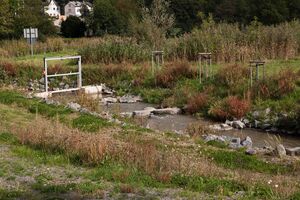Ecological Connectivity - Mission
From BAWiki

With the revision of the Federal Water Act (WHG) in 2010, the German Federal Government committed itself to maintaining or restoring the ecological connectivity at barrages on federal waterways. The aim is to fulfil the objectives of the EU Water Framework Directive (WFD), which requires a good ecological state in running waters. This requires, amongst other things, that the number of fish migrating through the rivers, and the biodiversity of the rivers, should correspond to those of a natural state. At present, this ecological connectivity does not exist in many federal waterways because of regulatory measures like damming and regulation of rivers to obtain sufficiently deep navigation channels. Also, the resulting drops in water heads are used to provide hydropower. Therefore it is necessary to provide functional fishways for upstream and downstream migration all over Germany or achieve river connectivity by alternative measures. The BAW, in close cooperation with the Federal Institute of Hydrology (Bundesanstalt für Gewässerkunde, BfG), assists the Federal Waterways and Shipping Administration (WSV) to ensure the adherence to and implementation of biological and structural requirements using state of the art technology.
In the BAW, this task is the responsibility of section W1 (Waterways and Environment). The task includes giving expertise relevant to planning and design steps and support services for the WSV (at all stages from preliminary planning to implementation, and the efficiency control required subsequently). The individual working steps are carried out, in each case, in agreement and cooperation with the BfG.
To enable and/or improve fish passage in federal waterways new structures (e.g. fishpasses) have to be realized or existing structures have to be improved. According to current scientific knowledge, in general structures for upstream migration differ from structures for downstream migration, as there are significant differences in the behavior of fish, depending on the direction of their migration.
The BAW and BfG have jointly drawn up the Guideline "Upstream Fishways on German Federal Waterways” to especially assist the WSV and also external planners that work for WSV. At present the guideline´s emphasis is on issues and working steps regarding the upstream migration of fish. Some aspects of downstream migration are considered. In the guideline, apart from the working procedure, the ecological and technological-hydraulic aspects and essential factors for planning and construction of upstream fish pass facilities are presented and discussed. The guideline is to be revised to ensure the inclusion of new developments and research results. In addition to the guideline a BAWLetter (BAWBrief) on “Requirements for the Planning of Fish Lifts and Fish Locks” was published.
In order to fulfil its tasks regarding the topic of fish passage on federal waterways, section W1 pursues its own research and development projects, which deal with a range of questions regarding structural and hydraulic issues of upstream fishways. Section W1 conducts R&D activities employing hydraulic and mathematical models and, lately, also ethohydraulic models (models with living fish). In addition, research contracts are placed with the scientific community.
- Guideline "Upstream Fishways on German Federal Waterways”
- BAWLetter “Requirements for the Planning of Fish Lifts and Fish Locks”
- International Rules and Guidelines
- Literature Study on Fishlifts and Fishlocks (German only)
Back to: Ecological Connectivity
